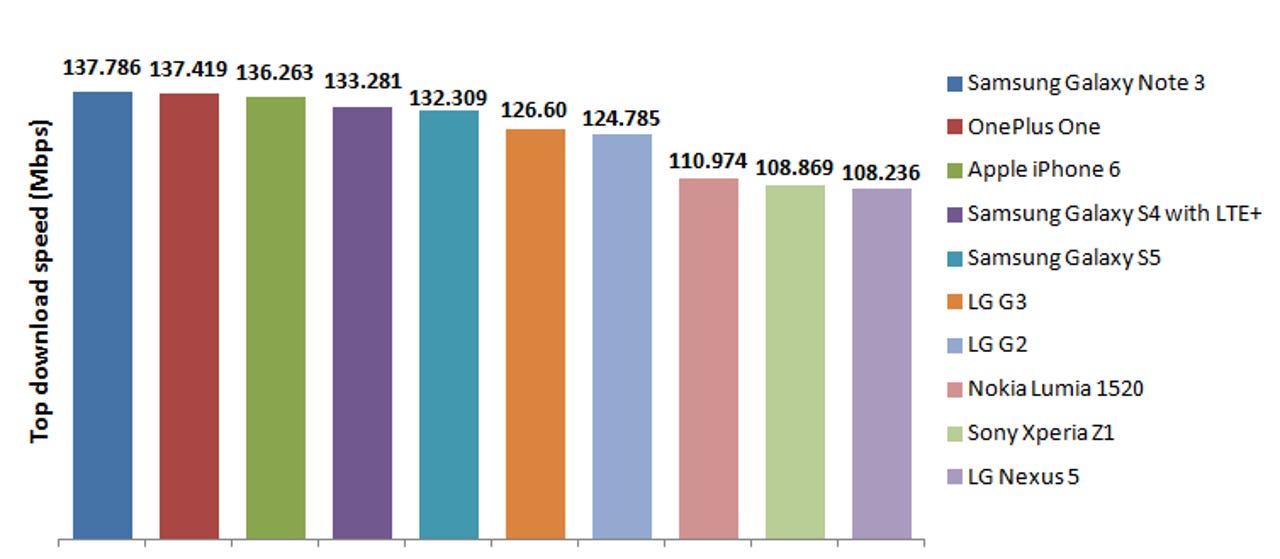Who makes the fastest-downloading smartphones in the world? Hint: it's not Apple

Mirror mirror on the wall, who makes the fastest smartphone of them all? Questions about the performance of various smartphone brands can fuel the most heated of flame wars, but thanks to researchers at Aalto University in Finland, the debates may finally be put to bed once and for all.
The academics' Netradar app has so far measured the real world upload and download performance of over 4,500 smartphones across different networks around the world. The results are likely to raise some eyebrows.
In the race for speediest phone, first place went to Samsung's huge Galaxy Note 3 phablet, but the real talking point is the second place finish of the relatively unknown OnePlus One. The results show an average of every handset's top five fastest download speeds recorded on the Netradar app, with the Galaxy Note 3 and OnePlus One recording incredible results of 137.8Mbps and 137.4Mbps, respectively.
It's a bit of a coup for the OnePlus One, the debut handset from Chinese manufacturer OnePlus which currently sells the handset on an invite-only basis - especially as it topped Apple's new iPhone 6, which came third with speeds of up to 136.3Mbps.

Aalto University's School of Electrical Engineering has been measuring and sharing the quality of mobile broadband since 2013 through the Netradar app, which is available free to download for almost any mobile operating system. It works by anonymously gathering data about phone and mobile internet performance around the world including Europe, Asia, and the US.
"We are talking about real speeds that people actually get when using their phones. We can analyse that data by looking into upload and download speeds, latency, which operator, network and device is used and so on," says Professor Jukka Manner, head of the Netradar project.
"What really has surprised me is how big the differences between smartphones are. A big price tag doesn't necessarily guarantee fast internet."
The phenomenon is clear with the 8th fastest handset, Nokia's Lumia 1520 phablet, which is almost 30 percent slower than the Note 3, which retails for around the same price unlocked.
Outside the top 10 the results are equally dramatic. Looking through the best-selling phones in the UK for September, HTC's One M8 is way off the pace with a top speed of 90Mbps – in line with the last generation Apple iPhone 5S and 5C. Unsurprisingly, the difference 4G makes to a handset is also huge with the 3G-only iPhone 4S left far behind with 12Mbps.
These are the second set of results from Netradar (the first were published in March) and even with only two sets of results it shows how quickly the sector changes. Previously the highest performer was LG's G2; seven months on, it's now seventh, while its successor, the G3, is just a place above in sixth.
It's all about the upload
But download results are only half the story. In today's world of social sharing there is increasing emphasis on upload speeds to accelerate everything from uploading photos to Flickr and Instagram, sharing a video on Facebook or starting a video call.
"I think that the impact of 4G will be the most significant on upload speeds as they could be ten times faster than now. But if a device can't reach those speeds, it doesn't matter how fast your mobile network is," says Manner.
Looking at the upload speeds, the picture changes significantly. Notably the OnePlus One, iPhone 6 and LG G3 all drop out of the top 10, despite reaching speeds of between 41Mbps and 43Mbps. Instead the Samsung Galaxy S5 leads the way with an upload speed of 47Mbps. It's closely followed by the Galaxy S4 with LTE+ (also known as I9506), LG G2 (with the newer G3 surprisingly back in 32nd place with 42.8Mbps), Nokia Lumia 920, and Samsung Galaxy Note 3.
Oldies continue their comeback in the uploads categories as the iPhone 5S climbs into the top ten ahead of the iPhone 6. Meanwhile, the HTC One M8 is relatively lacklustre here as well, coming 49th with an upload speed of 38.8Mbps.
Again the iPhone 4S emphasises the importance of having 4G, as its 3G restriction means it's way down the list with a top upload speed of 4Mbps. It's joined here by other high-profile 3G-only phones like the original Samsung Galaxy S3 (a 4G variant did follow) and Nokia 808 PureView which both clock in under 7Mbps.
Separately the Netradar results also serve as a timely reminder that not everyone is using a cutting-edge device. In fact, most results were gathered from the near three-year-old Samsung Galaxy S II which has topped 100,000 measurements. Similarly second place went to the two-year-old Sony Ericsson Xperia Acro S, a midrange 3G-only smartphone.
Nordic advantage
What about the carriers? Analyst Ovum recently surprised many concluding the US has faster broadband than any European country. In sharp contrast, Netradar's mobile broadband data places the US way down in 26th place with average combined 4G and 3G download speeds of just 5.3Mbps.
The UK does little better coming 20th with 6.1Mbps and neither country comes close to the two dominant regions: Asia and the Nordics.
Denmark, Norway, Sweden, and Finland are inside the top ten countries with the fastest average mobile broadband, though the clear leader is Singapore (16Mbps) followed by Switzerland and South Korea. Spain fights back for Europe, while Hong Kong and Japan complete the strong Asian showing.
Importantly for users, these average speeds fall well within the capabilities of most smartphones. That said the fastest network speeds recorded show handsets can be tested to their limit.
Germany produced the fastest individual recorded speed at a whopping 170.576Mbps. Finland isn't far behind with 164.2Mbps while the rest of the top 10 is populated by Singapore, Hungary, Denmark, France, Norway, the UK and Latvia while Canada brings up the rear at 93.9Mbps. Netradar publishes a map of its real time measurement data for those keen to see how their location and operator measure up.
Manner stresses this data shows dislocation between the highest peak speeds of 4G in ideal conditions and the averages users typically experience. Particularly in different areas within a country. He also states that recording real world measurements (affected by problems like location, network congestion, and data plan caps) are key to building meaningful data.
"Unlike some apps, we are not a signal tool. In truth, signal strength doesn't tell you much about what can be expected or measure the quality of an internet connection in a certain location. You can have a good signal but if, for example, the network is congested the signal strength won't make any difference. We focus on the speeds that can realistically be experienced," Manner says.
This determination to expose the reality behind our mobile broadband experiences drove Manner and two Netradar colleagues, Sebastian Sonntag and Lennart Schulte, to publish the paper 'Mobile Network Measurements - It's not all about signal strength' (subscription required) last year. As Netradar measurements continue to build, it is clear carriers and mobile phone makers will soon have nowhere left to hide.